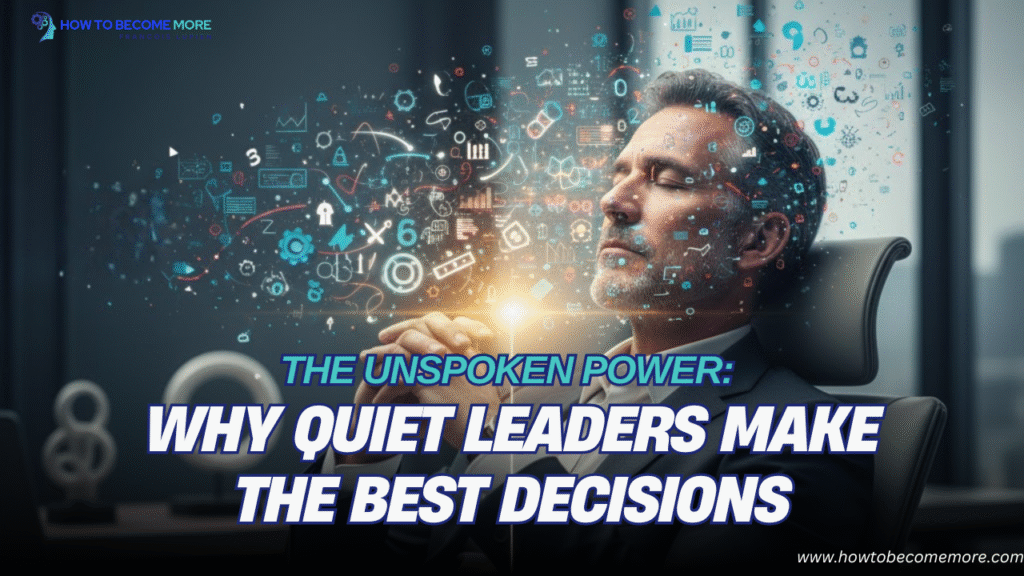For most CEOs, the moments before a major decision feel like standing at the crossroads of opportunity and risk. You’ve gathered the data, consulted advisors, and rehearsed every possible outcome — yet somehow, clarity still feels out of reach.
That’s because leadership decisions rarely suffer from a lack of information. They suffer from a lack of quiet.
In a world obsessed with urgency and noise, silence has become a rare, almost rebellious act. Yet for those who embrace it, silence often reveals what endless analysis cannot: truth, intuition, and alignment.
The Paradox of Leadership Noise
Every CEO knows what it feels like to be surrounded by sound — meetings, messages, metrics, opinions, expectations. The external noise is relentless, yet the real distraction often lives inside the mind: the constant stream of thoughts, doubts, and “what ifs.”
I once worked with a CEO leading a $50M company who found himself paralyzed between two major strategic choices. Both options looked promising, and both carried risk. He had spreadsheets, market forecasts, and expert advice — still, he couldn’t decide.
When he came to me, he said something I’ve heard many times:
“I’ve analyzed everything, yet I still don’t know what’s right.”
So I asked him, “What if the answer isn’t in the data, but in the space between your thoughts?”
That question changed everything.
Silence: The Hidden Decision-Making Superpower

When leaders allow themselves to enter total silence — not to escape decisions, yet to meet them differently — something profound happens.
Silence slows down the mind long enough for intuition to surface. It reconnects you to a deeper intelligence that isn’t driven by fear, pressure, or ego. It allows your decision to move from reaction to response — from anxiety to alignment.
Neuroscience supports this. Studies show that moments of silence activate the brain’s default mode network — the system responsible for insight, creativity, and emotional regulation. In other words, silence helps leaders connect the dots that logic alone can’t see.
This is why the most visionary leaders — from Satya Nadella to Steve Jobs — deliberately create quiet time before major decisions. They understand that silence isn’t wasted time. It’s integration time.
Three Shifts CEOs Experience in Silence

Through my work with executives, I’ve seen a consistent pattern when they learn to embrace silence as part of their decision-making process.
1. From Noise to Knowing
At first, silence feels uncomfortable. The mind rebels, insisting that thinking harder will solve the problem. Yet as the noise settles, leaders often describe a surprising moment of stillness — and with it, a quiet sense of knowing.
They realize that clarity isn’t something to chase; it’s something to allow.
2. From Urgency to Presence
When you pause before acting, you reclaim authority over your time. Urgency often disguises fear — the fear of missing out, of losing control, of not appearing decisive. Yet presence reveals that deliberate action, born of calm awareness, always outperforms rushed reaction.
Silence transforms urgency into intentionality.
3. From Overthinking to Alignment
Every major decision carries emotion beneath the logic — fear, excitement, uncertainty. Silence gives space for those emotions to speak, and when they do, hidden motives become clear. Once you see them, decisions stop feeling heavy. They simply feel right.
A Real-World Example: The Power of the Pause
A technology CEO I recently coached was preparing to acquire a smaller competitor. The numbers made sense. The advisors were confident. Yet something inside him hesitated.
He couldn’t name the hesitation — only that it didn’t feel aligned.
Instead of pushing through, he agreed to do something radical: he cleared his calendar for one hour, turned off all notifications, and sat in complete silence. No agenda. No journaling. Just presence.
Halfway through, he realized what had been bothering him — the acquisition would have forced him to abandon a core cultural value his company stood for. The spreadsheets never revealed that; silence did.
He decided not to move forward, and months later, he said,
“That hour of silence saved me from a year of regret.”
Why Silence Feels So Difficult for Leaders
Many CEOs resist silence because it challenges their identity. They’re used to solving, leading, deciding, doing.
Silence asks them to simply be.
In a culture that glorifies action, stillness feels unproductive. Yet the truth is, silence is where the most profound decisions are born — not through logic alone, yet through alignment between the head, the heart, and the gut.
It’s in silence that the leader reconnects with the human behind the title.
How to Practice Silence Before a Big Decision

Here’s a simple way to begin integrating silence into your decision-making process:
Step 1 – Create Space Find a quiet room or neutral environment — no screens, no interruptions. This is not a meditation session; it’s a leadership discipline.
Step 2 – Set the Intention Take one decision that feels heavy. Bring it to mind, then consciously set it aside. Tell yourself: “I’m not here to solve this. I’m here to listen.”
Step 3 – Embrace the Stillness Sit for ten minutes. Notice the flood of thoughts — they’ll come fast at first. Then, slowly, the noise fades. What remains is often what truly matters.
Step 4 – Record the Insight After the silence, jot down what surfaced. You may not have a full answer yet, yet you’ll feel a shift — more certainty, more calm, more connection to what’s right.
The C.U.R.R.E.™ Connection

Silence fits perfectly within my C.U.R.R.E.™ Method for executive transformation:
- Clarify your vision — Silence clears mental clutter, making the real objective visible again.
- Uncover hidden challenges — Quiet reflection reveals emotional or ego-driven motives that data can’t show.
- Remove the friction — It dissolves overthinking and resistance.
- Replace with flow — You start making decisions from calm confidence rather than fear.
- Engrain for lasting change — Over time, silence becomes a leadership habit, not a one-time tactic.
This is how CEOs move from reactive to responsive, from stressed to strategic.
Integration Assignment

Before your next major decision, try this:
- Block out ten minutes on your calendar labeled “Strategic Silence.” Yes — actually schedule it.
- Turn off every notification, close your eyes, and let your breathing slow. When your mind races, simply observe it. When it settles, listen inwardly.
- Then write down your insights.
You’ll likely discover that your next move isn’t hidden in complexity — it’s waiting in simplicity.
The Silent Advantage
Silence doesn’t mean withdrawal. It’s not weakness or hesitation. It’s leadership maturity — the recognition that power doesn’t come from constant motion, yet from grounded awareness.
The best CEOs don’t make faster decisions. They make clearer ones.
And clarity rarely shouts. It whispers… in silence.
Final Reflection
If you find yourself in a season of noise, where the world demands decisions before you’re ready, remember this: stillness is not wasted time. It’s the birthplace of wisdom.
When you embrace silence before your next big decision, you’ll find that the answers aren’t out there — they’ve been within you all along.
I work with CEOs and top executives through confidential conversations that sharpen clarity, strategy, and leadership presence. – I Promise Progress – If this resonates, let’s connect.





